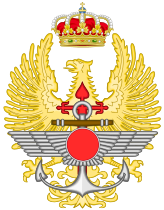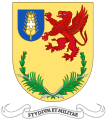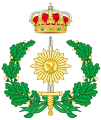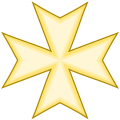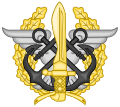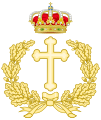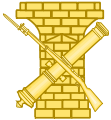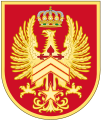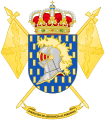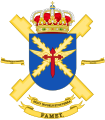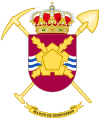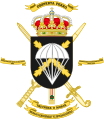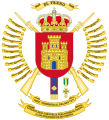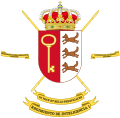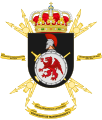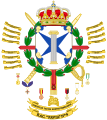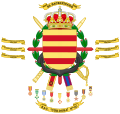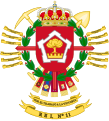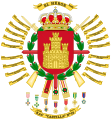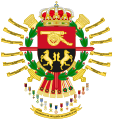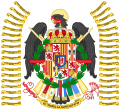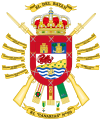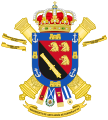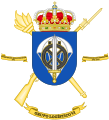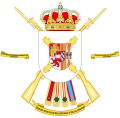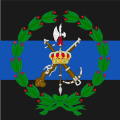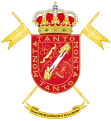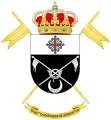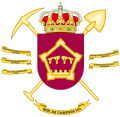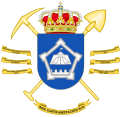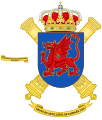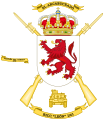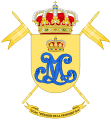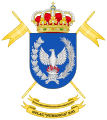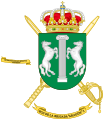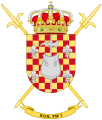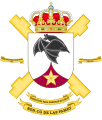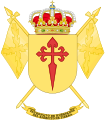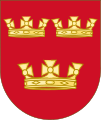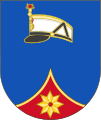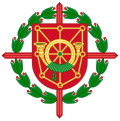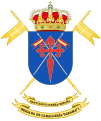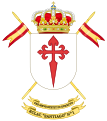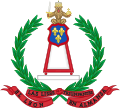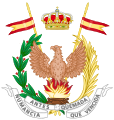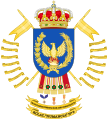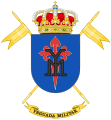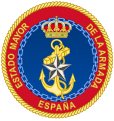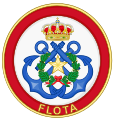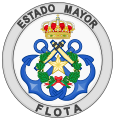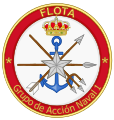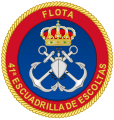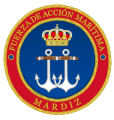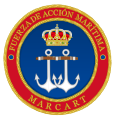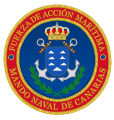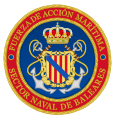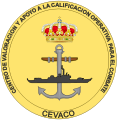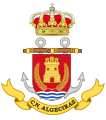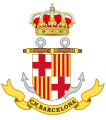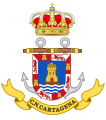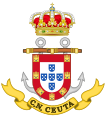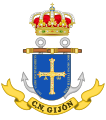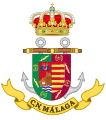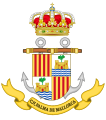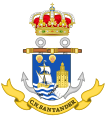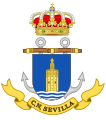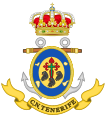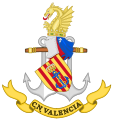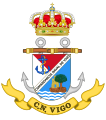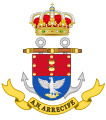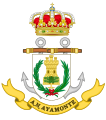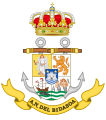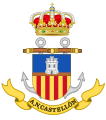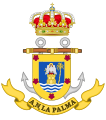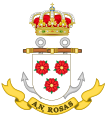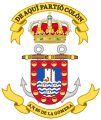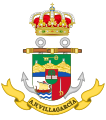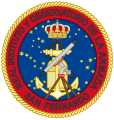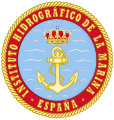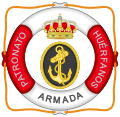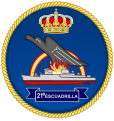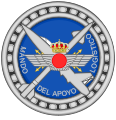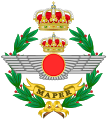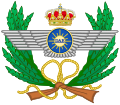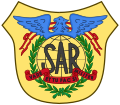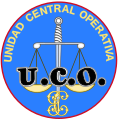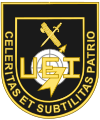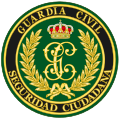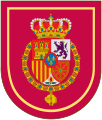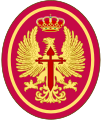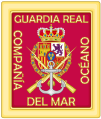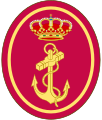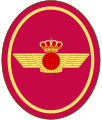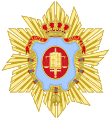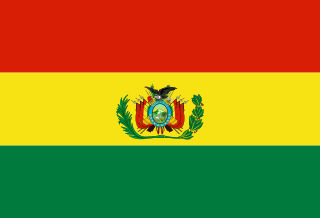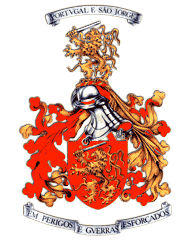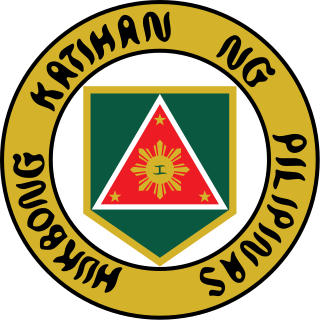Coat of Arms of the 1st Intelligence Regiment (RINT-1)
Coat of Arms of the 1st Information Operations Regiment (ROI-1)
Coat of Arms of the 1st CBRN-Defense Regiment "Valencia" (RDNBQ)
Coat of Arms of the 1st Engineer Regiment
(RINT-1)
Coat of Arms of the 1st Signal Regiment (RT-1)
Coat of Arms of the 2nd Infantry Regiment "La Reina" (RI-2)
Coat of Arms of the 3rd Infantry Regiment "Príncipe" (RI-3)
Coat of Arms of the 3rd Cavalry Regiment "Montesa" (RC-3)
Coat of Arms of the 4th Armoured Regiment "Pavía" (RAC-4)
Coat of Arms of the 4th Coastal Artillery Regiment (RACTA-4)
Coat of Arms of the 6th Infantry Regiment "Saboya"
(RI-6)
Standardized
Coat of Arms of the 6th Infantry Regiment "Saboya"
(RI-6)
Common
Coat of Arms of the 7th Engineer Regiment (RING-7)
Coat of Arms of the 8th Engineer Regiment (RING-8)
Coat of Arms of the 9th Infantry Regiment "Soria" (RI-9)
Coat of Arms of the 10th Armored Cavalry Regiment "Alcántara" (RCAC-10)
Coat of Arms of the 10th Armored Regiment "Córdoba"
(RAC-10)
Standardized
Coat of Arms of the 10th Armored Regiment "Córdoba"
(RAC-10)
Common
Coat of Arms of the 11th Cavalry Regiment "España" (RC-11)
Coat of Arms of the 11th Field Artillery Regiment (RACA-11)
Coat of Arms of the 11th Engineers' Specialities (REI-11)
Coat of Arms of the 12th Cavalry Regiment "Farnesio" (RC-12)
Traditional and common emblem of the 12th Cavalry Regiment "Farnesio"
(RC-12)
Coat of Arms of the 12th Bridge Engineer Regiment (RPEI-12)
Coat of Arms of the 16th Armored Regiment "Castilla"
(RAC-16)
Standardized
Coat of arms of the 16th Armored Regiment "Castilla"
(RAC-16)
Common
Coat of Arms of the 20th Field Artillery Regiment (RACA-20)
Coat of Arms of the 21st Signal Regiment (RT-21)
Coat of Arms of the 22nd Signal Regiment (RT-22)
Coat of Arms of the 29th Infantry Regiment "Isabel la Católica"
(RI-29)
Ornamented
Coat of Arms of the 29th Infantry Regiment "Isabel la Católica"
(RI-29)
Common
Coat of Arms of the 30th Mixed Artillery Regiment (RAMIX-30)
Coat of Arms of the 31st Mechanized Infantry Regiment "Asturias" (RIMZ-31)
Standardized
Coat of Arms of the 31st Electronic Warfare Regiment (REW-31)
Coat of Arms of the 32nd Mixed Artillery Regiment (RAMIX-32)
Coat of Arms of the 32nd Electronic Warfare Regiment (REW-32)
Coat of Arms of the 45th Infantry Regiment "Garellano", (RI-45)
Coat of Arms of the 49th Infantry Regiment "Tenerife"
(RI-49)
Coat of Arms of the 50th Infantry Regiment "Canarias"
(RI-50)
Standardized
Coat of Arms of the 50th Infantry Regiment "Canarias"
(RI-50)
Common
Coat of Arms of the 61st Armoured Infantry Regiment "Alcázar de Toledo" (RIAC-61)
Coat of Arms of the 62nd Infantry Regiment "Arapiles" (RI-62)
Coat of Arms of the 63rd Infantry Regiment "Barcelona" (RI-63)
Coat of Arms of the 63rd Rocket Artillery Regiment (RALCA-63)
Coat of Arms of the 64th Mountain Hunters Regiment "Galicia" (RCZM-64)
Coat of Arms of the 66th Infantry Regiment "América" (RI-66)
Coat of Arms of the 67th Infantry Regiment "Tercio Viejo de Sicilia" (RI-67)
Coat of Arms of the 71st Air Defence Artillery Regiment (RAAA-71)
Coat of Arms of the 73rd Air Defence Artillery Regiment (RAAA-73)
Coat of Arms of the 74th Air Defence Artillery Regiment (RAAA-74)
Coat of Arms of the 93rd Field Artillery Regiment (RACA-93)
Coat of Arms of the 94th Air Defence Artillery Regiment (RAAA-94)
Coat of Arms of the 1st-1 NBC-Defense Battalion (BNBQ I/1)
Coat of Arms of the 1st-1Combat Engineer Battalion
(BZAP-I/1)
Coat of Arms of the 1st-2 Protected Infantry Battalion "Princesa" (BIP-I/2)
Coat of Arms of the 1st-3 Protected Infantry Battalion "San Quintín" (BIP-I/3)
Coat of Arms of the 1st-4 Tank Infantry Battalion "Flandes" (BICC-I/4)
Coat of Arms of the 1st-3 Armored Cavalry Group "Cazadores de África" (GCAC-I/3)
Coat of Arms of the 1st-4 Coastal Artillery Battalion (GACTA-I/4)
Coat of Arms of the 1st-6 Mechanized Infantry Battalion "Cantabria" (BIMZ-I/6)
Coat of Arms of the 1st-7 Combat Engineer Battalion I/7
(BZAP-I/7)
Coat of Arms of the 1st-8 Combat Engineer Battalion
(BZAP-I/8)
Coat of Arms of the 1st-9 Protected Infantry Battalion "Fuerteventura" (BIPROT-I/9)
Coat of Arms of the 1st-10 Armored Cavalry Group "Taxdirt" (GCAC-I/10)
Coat of Arms of the 1st-10 Tank Infantry Battalion "Málaga"
(BICC-I/10)
Coat of Arms of the 1st-11 Light Armored Cavalry Group "Lanceros de Borbón" (GCLAC-I/11)
Coat of Arms of the 1st-11 Field Artillery Battalion (GACA-I/11)
Coat of Arms of the 2nd-11 Field Artillery Battalion (GACA-II/11)
Coat of Arms of the 1st-11 Road Building Battalion
(BCAM-I/11)
Coat of Arms of the 2nd 11 Camp Building Battalion
(BCAS-II/11)
Coat of arms of the 1st-12 Light Armored Cavalry Group "Santiago"
(GCLAC-I/12)
Coat of Arms of the 1st-12 Bridge Building Battalion
(BPON-I/12)
Coat of Arms of the 2nd-12 Railroad Building Battalion
(BEI-II/12)
Coat of Arms of the 1st-16 Tank Infantry Battalion "Mérida"
(BICC-I/16)
Coat of Arms of the 1st-20 Field Artillery Battalion (GACA-I/20)
Coat of Arms of the 1st-29 Protected Infantry Battalion "Zamora" (BIP-I/29)
Coat of Arms of the 1st-30 Field Artillery Battalion (GACA-I/30)
Coat of Arms of the 1st-31 Mechanized Infantry Battalion "Covadonga" (BIMZ-I/31)
Coat of Arms of the 1st-32 Field Artillery Battalion (GACA-I/32)
Coat of Arms of the 1st-45 Motorized Infantry Battalion "Guipúzcoa" (BIMT-I/45)
Coat of Arms of the 1st-47 Motorized Infantry Battalion "Filipinas" (BIMT-I/45)
Coat of Arms of the 1st-49 Motorized Infantry Battalion "Albuera"
(BIMT-I/49)
Coat of Arms of the 1st-50 Protected Infantry Battalion "Ceriñola"
(BIPROT-I/50)
Coat of Arms of the 1st-61 Tank Infantry Battalion "León"
(BICC-I/61)
Coat of Arms of the 1st-62 Mechanized Infantry Battalion "Badajoz" (BIMZ-I/62)
Coat of Arms of the 1st-63 Motorized Infantry Battalion "Cataluña"
(BIMT-I/63)
Coat of Arms of the 1st-63 Rocket Artillery Group (GALCA-I/63)
Coat of Arms of the 1st-64 Mountain Hunters Battalion "Pirineos" (BCZM-I/64)
Coat of Arms of the 1st-64 Skiing-Climbing Company
(CEE-1/64)
Coat of Arms of the 1st-66 Motorized Infantry Battalion "Montejurra" (BIMT-I/66)
Coat of Arms of the 1st-67 Motorized Infantry Battalion "Legazpi" (BIMT-I/67)
Coat of Arms of the 1st-71 Air Defence Artillery Battalion (GAAA-I/71)
Coat of Arms of the 1st-73 Aspide Air Defence Artillery Battalion
(GAAA-ASPIDE-I/73)
Coat of Arms of the 1st-74 Air Defence Artillery Battalion
(GAAA I/74)
Coat of Arms of the 1st-93 Field Artillery Battalion (GACA-I/93)
Coat of Arms of the 1st-94 Air Defence Artillery Battalion (GAAA-I/94)
Coat of Arms of the 1st Engineer Battalion
(BZAP I)
Coat of Arms of the 1st Signals Company
(CIATRANS-1)
Coat of Arms of the 2nd-2 Mechanized Infantry Battalion "Lepanto" (BIMZ-II/2)
Coat of Arms of the 2nd-3 Protected Infantry Battalion "Toledo" (BIP-II/3)
Coat of Arms of the 2nd-4 Cavalry Armored Group "Húsares de la Princesa"
(GCAC-II/4)
Coat of Arms of the 2nd-6 Protected Infantry Battalion "Las Navas" (BIP-II/6)
Coat of Arms of the 2nd-32nd Air Defence Artillery Battalion (GAAA-II/32)
Coat of Arms of the 2nd-10 Armored Cavalry Group "Almansa"
(GCAC-II/10)
Coat of Arms of the 2nd-11 Light Armored Cavalry Group "Numancia"
(GLCAC-II/11)
Coat of Arms of the 2nd-16 Armored Cavalry Group "Calatrava"
(GCAC-II/16)
Coat of Arms of the 2nd–30th Air Defence Artillery Battalion (GAAA-II/30)
Coat of Arms of the 2nd-31 Protected Infantry Battalion "Uad Ras" (BIP-II/31)
Coat of Arms of the 2nd-71 Air Defence Artillery Battalion (GAAA-II/71)
Coat of Arms of the 2nd-73 NASAMS Air Defence Artillery Battalion
(GAAA-NASAMS-II/73)
Coat of Arms of the 2nd-74 Air Defence Artillery Battalion (GAAAM-II/74)
Coat of Arms of the Coat of Arms of the 2nd-63 Information and Location Artillery Battalion
(GAIL-II/63)
Coat of Arms of the 3rd-73 Patriot Air Defence Artillery Battalion
(GAAA-PATRIOT-III/73)
Coat of Arms of the 3rd-74 Repair Unit (UR-III/74)
Coat of Arms of the 7th Field Artillery Battalion
(GACA-VII)
Coat of Arms of the 7th Engineer Battalion
(BZAP-VII)
Coat of Arms of the 7th Signals Company
(CIATRANS-7)
Coat of Arms of the 10th Field Artillery Battalion
(GACA-X)
Coat of Arms of the 10th Engineer Battalion
(BZAP-X)
Coat of Arms of the 10th Signals Company
(CIATRANS-10)
Coat of Arms of the 11th Field Artillery Battalion
(GACA-XI)
Coat of Arms of the 11th Engineer Battalion
(BZAP-XI)
Coat of Arms of the 11th Signals Company
(CIATRANS-11)
Coat of Arms of the 12th Armored Cavalry Group "Villaviciosa"
(GCAC-XII)
Coat of arms of the 12th Self Propelled Field Artillery Battalion
(GACA ATP XII)
Coat of Arms of the 12th Engineer Battalion
(BZAP-XII)
Coat of Arms of the 12th Signals Company
(CIATRANS-12)
Coat of Arms of the 16th Light Armored Cavalry Group "Milán" XVI (GCLAC-XVI)
Coat of Arms of the 16th Engineer Battalion
(BZAP-XVI)
Coat of Arms of the 16th Signals Company
(CIATRANS-16)
Coat of Arms of the 17th Signals Company
(CIATRANS-17)
Coat of Arms of the 18th Signals Company
(CIATRANS-18)
Coat of Arms of the Division "Castillejos" Headquarters
Coat of Arms of the Division "Castillejos" Headquarters Battalion
Coat of Arms of the Division "San Marcial" Headquarters
Coat of Arms of the Division "San Marcial" Headquarters Battalion
Coat of Arms of the Signal Battalion of the Air Defence Command (UTMAAA)
Coat of Arms of the 1st Brigade "Aragón" Headquarters Battalion
(BCG BR I)
Coat of Arms of the 7th Brigade "Galicia" Headquarters Battalion
(BCG BR VII)
Coat of Arms of the 10th Brigade "Guzmán el Bueno" Headquarters Battalion
(BCG BR X)
Coat of Arms of the 11th Brigade "Extremadura" Headquarters Battalion
(BCG BR XI)
Coat of Arms of the 12th Brigade "Guadarrama" Headquarters Battalion
(BCG BR XII)
Coat of Arms of the 16th Brigade "Canarias" Headquarters Battalion
(BCG BR XVI)
Coat of Arms of the Ceuta General Command Headquarters Battalion
(BCG-COMGECEU)
Coat of Arms of the Melilla General Command Headquarters Battalion
(BCG-COMGEMEL)
Coat of Arms of the Music Unit of the
RI-1 Coat of Arms of the Support Unit of the RI-1
Coat of Arms of the former 1st Light Armored Cavalry Regiment "Santiago" (RCLAC-1)
Coat of Arms of the former 2nd Signal Regiment
Coat of Arms of the former 4th Light Armoured Cavalry Regiment "Pavía" (RACAC-4)
Traditional Emblem of the former Cavalry Regiment "Almansa"
Coat of Arms of the former 5th Light Armoured Cavalry Regiment "Almansa" (RCLAC-5)
Traditional Emblem of the former Cavalry Regiment "Numancia"
Coat of Arms of the former 9th Light Armoured Cavalry Regiment "Numancia" (RCLAC-9)
Coat of Arms of the former 10th Mechanized Infantry Regiment "Córdoba"
(RIMZ-10)
Coat of Arms of the former 13th Railway Regiment
Traditional Emblem of the former Cavalry Regiment "Villaviciosa"
Coat of Arms of the former 14th Light Armoured Cavalry Regiment "Villaviciosa" (RCLAC-14)
Coat of Arms of the former 14th Field Artillery Regiment (RACA-14)
Coat of Arms of the former 16th Mechanized Infantry Regiment "Castilla"(RIMZ-16)
Coat of Arms of the former 22nd Hunter Cavalry Regiment "Victoria Eugenia"
Coat of Arms of the former 32nd Infantry Regiment San Quintín (RINF-32)
Coat of Arms of the former 37th Infantry Regiment Órdenes Militares
(RINF-37)
Coat of Arms of the former 51st Logistics Support Grouping
(AALOG-51)
Coat of Arms of the former 62nd Rocket Artillery Regiment (RALCA-62)
Coat of Arms of the former 72nd Air Defence Artillery Regiment
(RAAA-72)
Coat of Arms of the former 81st Air Defence Artillery Regiment (RAAA-81)
Coat of Arms of the former 91st Mixed Artillery Regiment (RAMIX-91)
